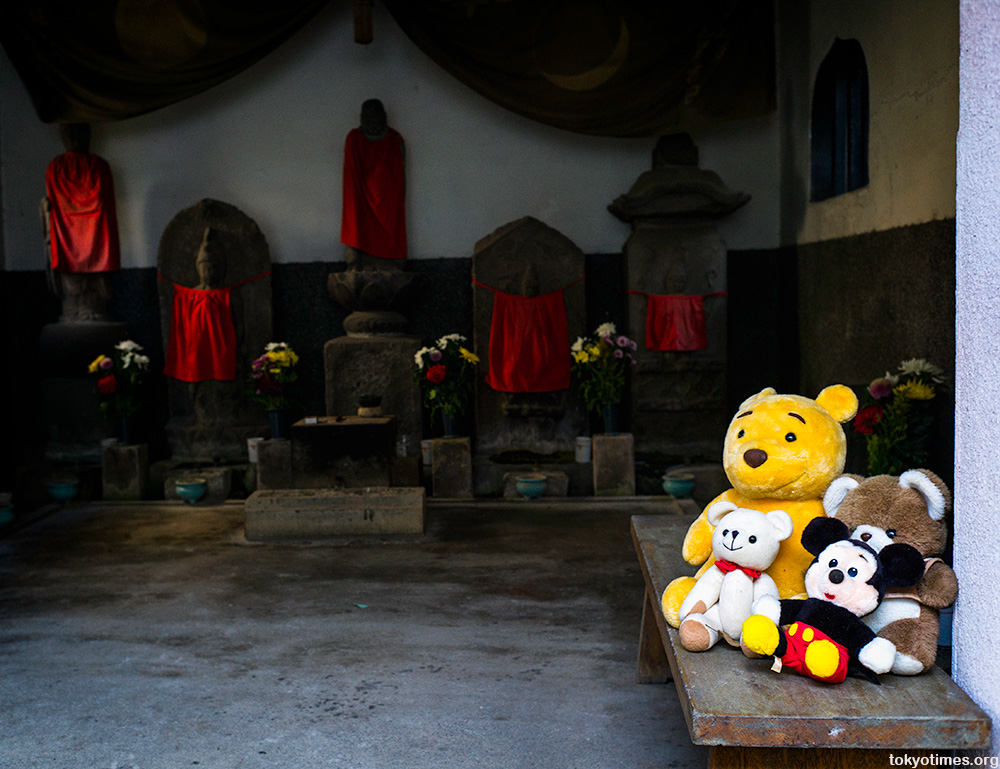Jizo are common sights in Tokyo — not to mention the whole of Japan. Little figures stood solemnly by the roadside. Or more often than not, in and around temples. Statues that along with watching out for youngsters and travellers, are far better known as the protectors of deceased children, including miscarried or stillborn infants. The belief being that Jizo hides them in his robes and then guides them safely to salvation.
However, invariably kitted out in red bibs and wooly hats, it’s easy to forget this sad reality behind the countless statues. Even more so the many people who dutifully go and pay respects to them. And yet at other times, it’s quite clearly, and very uncomfortably, the opposite.

Taro 3Yen says
Sort of sanitized “sadness” – Nowadays almost all Jizo statues are for the aborted and to protect from the bad juju of malefic Mizuko (æ°´å, literally ‘water child’). See: http://masamania.com/abortion-is-sad-thing-but-dont-afraid-dead-baby/
Lee says
Cheers for the link. That’s an interesting take on it!
The actually statues don’t have any affect on me at all, but those surrounded by toys and the like such as these always do. They invariably make me think about the story behind them.
Hans ter Horst says
I love the OjizÅ-sama and find them sad yet reassuring in their appearance. At the Okunoin graveyard in Koya-san, they have pyramids of old OjizÅ-samastatues.
However, I walked the 34 Kannon temples pilgrimage this year (very recommended, see my blog) and when walking towards Temple #31, I walked past another temple that, according to my guide, was a front for a commercial operation selling tiny OjizÅ-sama statues to families or women who had either aborted a foetus or miscarried. The guide sort of described it as a scam. Long story short, the temple grounds were a sea of OjizÅ-sama statues, you cannot imagine how many but those made me feel pretty bad.
Hans ter Horst says
Oops, the pilgrimage was in Chicihbu.
Lee says
I can imagine.
That’s rotten that the business is using people’s guilt/sadness to make some money. But from what you saw there’s clearly a big market there…
An Expat says
Indeed, a reminder if a recent broadcast by Fujisankei on The Pill. Now up to 1998 (when I returned home from Japan) The Pill was still not available to Japanese women as a contraceptive option, due to head in the sand, benighted “thinking†by those in the power (men, BTW) in Japan.
So while I do not know when The Pill was made available to Japanese women, but what raised the hackles with me was the broadcast cited data from a study from the early 2000’s to present in which there were less than 10 (7, I believe) deaths attributed to use of The Pill.
Now any death from a medication is a problem, but given Japanese resistance ( it would not surprise me to learn it was one of the last industrialized nation to legalize its use) to The Pill for contraception and myths bandied about on its supposed dangers, the attempt as I saw it, to use the data from the study as a statically significant indicator of a public health danger is……….only in Japan
Lee says
Yeah, I don’t know what the thinking was behind all that nonsense. I know it’s (finally) available now, but not sure how common it’s usage is. Not very I’d bet…
Jeffrey says
I took dozens of photos in my first couple of trips to Japan not knowing what they signified. I still find them compelling.
Lee says
Yes, I know what you mean. I was the same when I first came here. And they became even more compelling when I did find out what they were. Still are as well.
Valerie says
The Jizos I photographed in Kyoto and Hiroshima changed my life. It is Japan where Jizo evolved from the King of Vows, who promised Buddha he would stay on earth until everyone was finished suffering.
His Sanskrit name is Ksitigarbha and in all other countries he is still the protector, the King of Vows, called this because the vow to give care for eternity is the greatest vow there is. It was the crushing aftermath of WWII and forced abortions that caused the Mizuko Kuyo (water baby ceremony) to evolve, using Jizo to console the women who had no food for themselves! much less a new baby.
I use Jizo as the archetype for attachment therapy — a safe and loving figure to hold the inner baby within all of us safely.
Lee says
That’s very interesting. Thank you.
Amazing to hear how important they have become to you too.